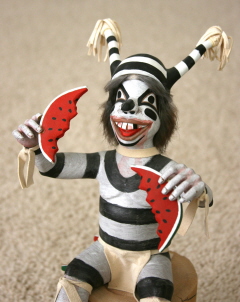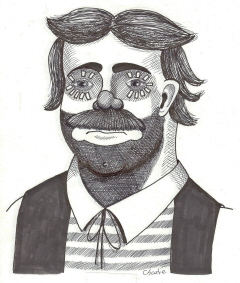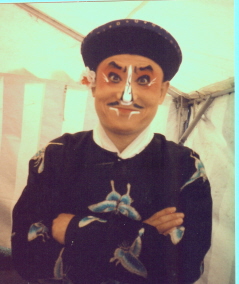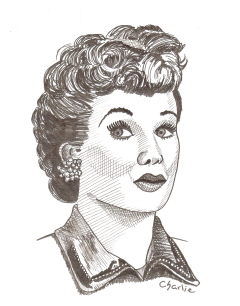Exclusive and Inclusive Clown Definitions
Written and Illustrated by
Bruce
“Charlie” Johnson
World Clown
Association
Historian
When
discussing clown history deciding how you are going to define clowning is one of
the first tasks.
There
are two approaches to creating a clown definition, exclusive and inclusive.
The
first method of defining a clown is describing the definitive clown.
Anything varying from that description is not a clown.
This is known as an exclusive definition because its purpose is to
exclude things that are not part of your group.
An example of an exclusive definition is competition rules.
About twenty years ago the competition rules specified that whiteface
clowns were required to wear gloves, and the only acceptable glove color was
white. At that time, if you wore red
gloves in a whiteface competition you did not fit the definition of a whiteface
clown so you were docked points which probably prevented you from winning.
The
second method of defining a clown is describing some general characteristics of
a clown. Then anything that fits
those characteristics is a clown.
This is known as an inclusive definition because its purpose is to gather
similar things into a group. That is
an approach that anthropologists use in studying different cultures.
For example, many of the indigenous tribes of
North America
have their own clown characters.
They don’t look like clowns you would see in WCA competition.
Many indigenous clown characters wore masks instead of make up.

Koshari Clown Kachina Figure
Photo by Richard Snowberg
They do
act like clowns and serve many of the same functions within their society that
clowns do within the Anglo Saxon culture.
When members of the
Cheyenne
tribe first attended a circus they recognized that Poodles Hanneford was a clown
because his equestrian act was similar to the performances of the Cheyenne
Contrary clowns. Native American Clowns
Here
is an example of the difference these two approaches make.
Tim Hollis used an exclusive definition when he wrote
Hi There Boys and Girls! America’s Local TV Programs.
He identifies television characters as
clowns only if they wore whiteface, auguste, or tramp style make up. (Types
of Clowns)
Karin Adir, a clown who has performed in theaters in
America
and Europe,
used an inclusive definition when she wrote
The Great Clowns of American Television.
The people that she identifies as clowns did not wear exaggerated make
up. They include Lucille Ball,
Milton Berle, Sid Caesar, and Imogene Coca.
Appearance
is used in many exclusive definitions, but that causes difficulties.
For example, from 1900 to 1910 W. C. Fields toured internationally as a
juggling tramp clown wearing what we would consider to be traditional tramp make
up. During that time he also
developed his pool table act and his golf act which he originally performed
while wearing his tramp clown make up.
When he became a part of the Ziegfield Follies cast in 1910, he performed
the identical acts but stopped using his tramp make up.
Does that mean he was a clown before 1910 but stopped being a clown when
he changed his appearance? He later
performed the juggling, golf, and pool acts he had created as a clown in his
movies. Since he didn’t use his
tramp make up in his movies were those acts no longer clown acts?
Since he performed the acts exactly like the way he had as a clown were
they still clown acts?

W. C. Fields in his Tramp Clown Make Up
Illustration by Bruce "Charlie" Johnson
It
is not unusual for clowns to refine or eliminate their make up design during
their career. Poodles Hanneford, an
International Clown Hall of Fame inductee, originally wore a heavy exaggerated
auguste make up inspired by Albert Fratellini.
Gradually he began making the areas of color smaller until he developed a
naturalistic appearance.
Using
an exclusive definition based on appearance means clowning began in the
nineteenth century. Joseph Grimaldi
introduced the modern style of whiteface clown in 1800.
According to legend, Tom Belling introduced the auguste character and
make up in 1869. McIntyre and Heath
introduced the modern tramp character in 1874.
However,
if you identify clowning by the type of act that was performed, the art form is
much older. Philip Astley developed
the first circus and performed Billy Buttons, the first circus clown act, in
1768. Astley performed the act
without make up, but it became a staple of circus clowns who did wear make up.
The act that Poodles Hanneford performed was a version of the Billy
Buttons act.

Poodles Hanneford
Illustration by Bruce "Charlie" Johnson
The
Commedia del Arte clown characters of the sixteenth and seventeenth century
Europe
did not look like modern clowns.
They wore leather masks instead of make up.
However, they are definitely part of the foundation of modern clowning.
The dentist routine that was described as
being performed by Doctore and Pantalone in the 1600’s is the same basic
routine being performed today by circus clowns.
The identical punchline, “Doctor, you pulled the wrong tooth,” is used
nearly 400 years after the routine was first performed.

Ezra Homison
and Tim Ruzicki as Doctore and Pantalone
Photo by Bruce "Charlie" Johnson
I
generally use an inclusive definition of clowning based on the type of comedy
performed and the role the performer plays in society.
During my first trip to
Singapore,
I visited the
South
East Asia
Museum
where I saw a video of a ceremony at a temple.
I saw two masked characters representing a woman and an old man.
Watching their interactions with those worshipping at the temple I
thought they were acting like clowns.
Right after I thought that, the narrator said, “These two clowns
contribute to the joyful nature of this celebration.”
I had properly identified them based on their actions.
I
am not always able to identify clowns based on their appearance.
I had the pleasure and privilege of appearing in the 1993 World Clown
Congress International Gala with a pair of clowns from
China’s
Peking Opera in
Beijing.
I learned that a distinguishing characteristic of a Chou, a clown from
the Peking Opera, is a white patch on the nose.
However, other characters in the Peking Opera may also have a white nose.
I can guess that a make up design might be a clown character, but I have
to consult a book like
Peking Opera Painted Faces,
published by Morning Glory Publishers, to verify that I am correct.

Wu Jinaping, Chou with the
Peking
Opera
Photo by Bruce "Charlie" Johnson
Whether
or not somebody identifies themselves as a clown is important.
Victor Borge performed some physical comedy routines similar to what
clowns perform. He has inspired many
clowns. When I had a chance to
interview Jim Colias, Borge’s long time business manager, Colias told me that
Borge respected clowns but considered himself a humorist instead of a clown. So
I do not classify Borge as a clown although I do include a page about him on my
web site. Victor Borge
Jackie
LeClaire was the producing clown for the first American circus to perform in the
Soviet Union.
Joe Jackson Jr. performed his famous break away bike act in that show.
When I talked with Jackie about the show, I referred to Joe Jackson Jr.
being a clown with the show. Jackie
corrected me by saying, “He wasn’t a clown.
He performed a comedy act.”
That distinction is important in the world of the circus.
If somebody performs a comedy act, they are hired specifically to do that
act. They receive greater respect
and much more pay than somebody hired for “general clowning.”
Somebody performing a comedy act may be
insulted if you refer to them as a clown. People
performing comedy acts may wear clown make up, but they are not considered to be
clowns by many circus people because they do not fulfill the functions of a
clown in a circus, which include filling rigging breaks, providing transitions
within the performance, and making additional public relation appearances..
So even though Joe Jackson Jr. wore tramp make up and costuming during
his comedy act some people do not classify him as a clown.
In
this column I will use an inclusive definition of clowning.
I’ll include characters that have been identified as clowns even if they
don’t fit the competition definitions.
I’ll also refer to people who may not be clowns, but who are similar to
clowns. I’ll try to refer to them as
“clown like” or “clown type” characters.
I will do that because we can learn from them.
One
reason is we can learn from them is that entertainers like Lucille Ball are a
link to clowns of the past whether or not they are officially clowns themselves.

Lucille Ball
Illustration by Bruce "Charlie" Johnson
Lucille
Ball was given the opportunity to do her television series only because of a
clown routine that she performed.
The television networks originally rejected her request to do a series
co-starring Desi Arnaz, her Cuban born husband.
They did not think the public would accept the two of them together.
To prove the concept would work, Ball and Arnaz went on a tour of
theaters and made a pilot film. The
basis for their act and pilot film was a musical clown routine created by Pepito
the Spanish Clown. Pepito supplied
them with the props, including a gimmicked cello, and taught Lucy how to do his
routine. The success of the act and
the pilot film convinced CBS to allow the couple to try their series.
Ball later repeated Pepito’s musical clown act in an episode
1
of her series, and he performed some of his other routines as a guest star on
another episode. 2
Her
writers were familiar with the art of clowning and incorporated clown routines
into her script. Clown acts
performed on her show include Slowly I Turned
3
and Otto Griebling’s tree delivery routine.
4
In one episode she performed the
traditional Mirror clown act with Harpo Marx
5.
In an episode of “The Lucy – Desi Comedy Hour,” Lucy plays a tramp clown
joining Red Skelton in a Freddie the Freeloader act.
6
The two do a song-and-dance number and then perform a pantomime set in a
restaurant.
When
her show did not incorporate actual clown routines, it can inspire new clown
routines. I have seen Marti Bloes
perform a peanut butter commercial routine that was based on Lucy’s
Vitameatavegamin routine.
7
The
entire I Love Lucy series is available on DVD.
Many other performances by clowns and clown type characters are available
on DVD. We are fortunate to be in an
era when so many performances are available for to study.
Any
definition of clowning should include that they are entertaining.
Click here to read one Definition of clowns.
We can learn many valuable lessons from other entertainers whether they
are officially clowns or not. The
history of variety arts in general is an important resource for modern clowns.
1
“The Audition,” Episode # 6,
November 19, 1951
2
“Lucy’s Show Biz Swan Song,” Episode
#52,
October 17, 1952
3
“The Ballet,” Episode #19,
January 11, 1952
4
“Ethel’s
Home
Town,”
Episode #113,
November 25, 1954
5
“Harpo
Marx,” Episode #124,
March 24, 1955
6
“Lucy Goes to
Alaska,” Episode # 8, February 9, 1959
7
“Lucy Does A Commercial,” Episode # 30, March 28, 1930)
Copyright 2010 by Bruce "Charlie" Johnson. All rights reserved.
This
article originally appeared in the February 2010 issue of Clowning
Around published by The World Clown Association.
The first World Clown Association Author Awards were presented at the 2011
WCA Convention in New York. The award recognized articles published in
Clowning Around during 2010. This article came in Second Place.
First Place was won by Lee Mullally. Third Place was won by Anita Thies.
For more information on the World Clown Association go to
www.worldclown.com





